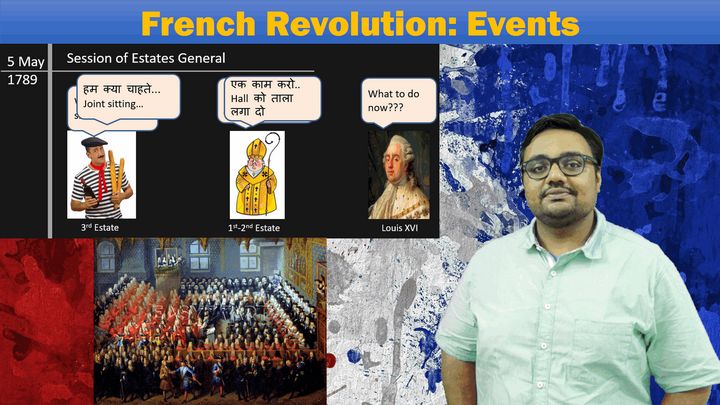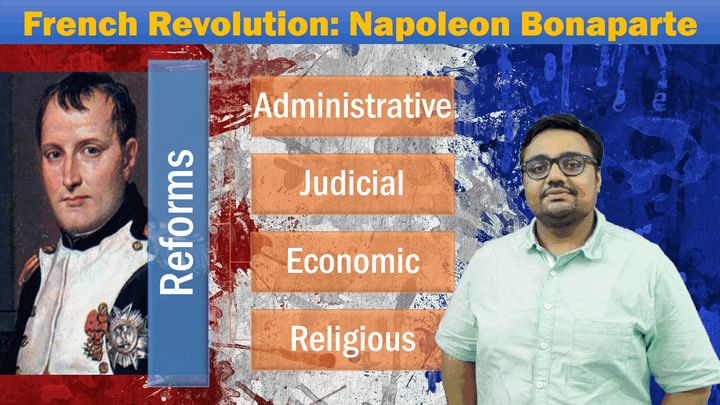- Prologue
- WHFr/P1: French Revolution: Political Causes, Divine right theory, Louis XVI
- WHFr/P2: French Revolution: Socio-Economic & Cultural causes
- WHFr/P3: French Revolution: Events, National Assembly, Bread Riots
- WHFr/P4: French Revolution: Outcomes, Impact, Significance
- WHFr/P5: French Revolution: Napoleon Bonaparte- rise, reforms & fall
Prologue
- In past lecture, Pratik Nayak covered the American revolution for World History for General Studies Mains Paper 1 (GSM1); and American Constitution for GSM2.
- Now moving forward with next topic: French Revolution- causes, events, outcomes and Napoleon
- PowerPoints available under Mrunal.org/download goto mediafire folder: “1_Powerpoint” => “3_History_Pratik” à “World History”
WHFr/P1: French Revolution: Political Causes, Divine right theory, Louis XVI
- The French Revolution opened a new chapter in the history of Europe. It marked a turning point in the history of humankind. The French Revolution put an end to the age old absolute monarchy, feudal laws and social inequality. It introduced for the first time the idea of republicanism based on “Liberty, Equality and Fraternity”. These ideas had influenced the entire continent of Europe and also the world
- The causes of the French revolution include the political, social and economic aspects that were prevalent in France before the outbreak of the revolution.
- Political Causes: France was ruled by the Bourbon dynasty. They firmly believed in the Divine Right theory – as they were representatives of God, they were answerable only to God. Louis XIV was a strong and powerful ruler of the Bourbon dynasty. His wars ruined the economy of France. His successors Louis XV and Louis XVI were weak administrators.
- Louis XV foretold at the end of his rule: “After me the deluge”. His words came to be true. Louis XVI was the most incompetent ruler. His wife and queen, Marie Antoinette interfered too much into the administration. She was thoroughly ignorant of the sufferings of the French people. But she always favoured and protected the interests of the French nobles. She did not allow the financial reforms to take place. Because it affected the interests of the nobles and the clergy.
Youtube Link: youtube.com/watch?v=wHE7qNMI904
WHFr/P2: French Revolution: Socio-Economic & Cultural causes
- Social Causes: The French society was based on inequality. The society consisted of three major divisions, the nobles, clergy and the common people. The nobles had no political power but remained loyal to the king. They enjoyed many privileges and led a life of luxury. They were exempted from taxation. The higher clergy owned one fifth of the lands in France and enjoyed several privileges. Their number in France was around only five thousand. They lived in palatial houses and they were exempted from taxes. But the lower clergy were denied all these privileges. Therefore, they turned against the higher clergy during the revolution. Both the noble and the higher clergy led a life of ease and pleasure without bothering about the wretched condition of the masses. The majority of the population in France belonged to the third category. Traders, lawyers, owners of industries, government servants, peasants and workers were in this category.
- While the nobles and the clergy were exempted from paying taxes, the masses paid all the taxes. Hence it was said : “the nobles fight, the clergy pray and the people pay”. The taille or land tax was entirely paid by the peasants. The gabelle or salt tax was a burden on the common man. The head of each family had to pay the capitation tax. Besides paying these taxes to the king, they have to pay tithe(tax) to the Church.
- The burden on the peasants was higher than the others because he had certain other obligations to the nobles. They were forced to use the mill, wine-press, slaughterhouse and oven of their lords after paying the usual dues. They were also compelled to render feudal services to the lords.
- The financial condition of France was very critical during the reign of Louis XVI. The national debt had increased beyond the limit. The national income was less than national expenditure. Hence, the king tried to mobilize national income by selling important offices of the government.
Youtube Link: youtube.com/watch?v=3-iikQ6Ktm4
WHFr/P3: French Revolution: Events, National Assembly, Bread Riots
- The States General consisted of three Estates Chambers. The first Estate was represented by the nobles, the second the clergy and the third by the common people. When the king called for its meeting, each Estate sat separately. However, the members of the third estate demanded a joint sitting and one vote for each member. As the first and second Estates did not concede to this demand, there was a deadlock. On 17th June 1789, the third Estate declared itself as the National Assembly. The king got alarmed and prevented them from entering the hall. But, the members of the National Assembly went to a nearby Tennis Court and took an oath to frame a new constitution. This is known as Tennis Court Oath.
- On 23rd June 1789, a special session of States General was held. The king declared the acts of the Third Estate as illegal. He also ordered that the three Estates should meet separately. But the third Estate refused to accept the king’s orders. Hence, Louis XVI submitted to the will of the third Estate, which represented the common people. He ordered the three Estates to sit together. Thus the formation of National Assembly was completed
- There was a shortage for bread in Paris. On 5th October, a large number of women went to the King’s palace at Versailles to make a petition. They were not satisfied with the reply of the queen and hence they brought with them the king, the queen and their son to Paris.
Youtube Link: youtube.com/watch?v=73MQSvgKkrU
WHFr/P4: French Revolution: Outcomes, Impact, Significance
- The National Assembly styled itself the Constituent Assembly. It drew up the Declaration of the Rights of Man. The new constitution drafted by the Constituent Assembly provided for a limited monarchy to France. The titles of the nobles were abolished. Judiciary was remodeled. The method of torture was abolished. New central and local courts were established. Judges were to be elected. Drastic action was also taken against the church. The monasteries were suppressed. Absolute religious toleration was proclaimed. The collection of tithes by the church was abolished. Then, measures were taken for the nationalization of church properties. After drafting the new constitution, the National Assembly dissolved itself in 1791.
- The French Revolution of 1789 inaugurated a new era in the history of the mankind. The ideas of “liberty, equality and fraternity” spread to other parts of the world. The Bourbon monarchy was abolished. The Revolution rejected tyranny, divine right, conservatism, and feudal vestiges associated with bourbon rule in France. At the same time it failed to establish a permanent Republic in France. The French Revolution, after a violent turn led to the emergence of a great dictator, Napoleon Bonaparte
Youtube Link: youtube.com/watch?v=oA6Ox2X2giQ
WHFr/P5: French Revolution: Napoleon Bonaparte- rise, reforms & fall
- French Revolution, after a violent turn led to the emergence of a great dictator, Napoleon Bonaparte
- In 1799 Napoleon Bonaparte had become the first consul of France and he made himself the most powerful person in France. In 1804 he crowned himself as the Emperor of the French and in the first years of the 19th century he became the most powerful person in Europe and he was not concealing his European ambitions.
- As the ruler of France, he also carried out numerous Administrative, judicial, economic and religious reforms.
Youtube Link: youtube.com/watch?v=hb8TpsO8blc.






![[Summary] Budget & Economic Survey 2018 Gist for the UPSC IAS/IPS Interviews](https://mrunal.org/wp-content/uploads/2018/02/c-bes18-basanti-500x383.jpg)
![[BES171] Banking-Classification: Wholesale Banks, Cooperative Banks, DFI AIFI, MUDRA Bank, Islamic Bank, NBFCs & Indigenous Moneylenders](https://mrunal.org/wp-content/uploads/2017/05/c-bes171-evo-2-500x383.gif)
![[BES171] Banking-Classification: RBI Structure Functions, Nationalization, Scheduled Banks, Merger of SBI Associate Banks & BMB, Private Banks, SFB & Payment Banks](https://mrunal.org/wp-content/uploads/2017/02/c-bes171-cover-500x383.gif)
बहुत बहुत धन्यवाद प्रतीक सर ।
thank you sir
ITS A REQUEST
PLEASE UPLOAD REST OF THE VIDEOS ASAP
PLEASE UPLOAD REST OF THE VIDEOS ASAP
Thank u sir ….plz keep enlightening us ….
Thank you mrunal sir and entire team
Thank you Pratik sir.
thank u very much sir..:)
Thank u very much sir
Thank you pratik sir
Thank you Sir
great sir
I think day will come when UPSC will take reference from mrunal’s site before checking answers seet of candidates.
Jyada ho gaya….
kuch jyada hogaya
Thanks pratik sir
Mrunal sir when are you going to start mains revision classes
Eagerly waiting sir
Thank you so much Pratik and Mrunal sir for ur efforts…:)
Sir, details like the writers and thinkers are missing. The phases in which revolution took part are missing.
great Initiative.sir please post videos in english also .A big request from those who cannot understand hindi. so else please add subtitles to the video .thank u
Thanx sir . thank you very much for series.but one request plz post lecture early.becoz too much time gap create. Boredom. Thanx once again.
sir,
I am from Manipur and I do not speak Hindi. so could plz upload the videos in English? It’s a humble request.
thanks
AWM
first of all..thank you sir a lot for providing such a knowledge in these areas of history. these are really helpful in starting of prep and provide a motivation for working even further to achieve our one n only goal…once again thanks!!!
thank you so much Prateek sir. This is indeed a great help. Highly simplified and easy explained :) Keep up the great work!
We r very much obliged to u…
Ur technique to teach students are amazing…
U have changed the view how to read history & world history especially….
Thanku sir
Yours
Ashish Pushkar